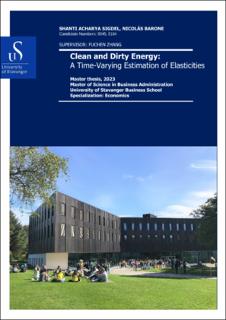| dc.description.abstract | Purpose – The success of economic green growth requires the degree of elasticity of substitution between the clean and dirty energy inputs to be more than one. This research studies the dynamics of the elasticity of substitution between the two energy inputs in the context of an economic growth model described by a CES nested into Cobb-Douglas specification function energy inputs. We also estimate the output elasticities of clean and dirty energy inputs. We use an updated version of the dataset compared to the previous literature on this field. Our methodology consists of a panel data on a dataset of 38 countries from 2000 to 2014 and a time-varying panel model to analyze the dynamics of the elasticities.
Design/Methodology/Approach – We estimate a linear version of the CES nested into Cobb-Douglas production function. The linear equation comes from the Kmenta approximation. We provide two estimations. First, in line with the previous literature, we estimate the model assuming equal weights in the production function for dirty and clean energy inputs. Here we compute the elasticity of substitution between both sources. For the second, we release that assumption and compute the elasticity of substitution between the two and the output elasticities of both sources. We also estimate a time-varying panel model. We compute the dynamics of the output elasticities of clean and dirty energy inputs and the elasticity of substitution between the energy inputs.
Findings – Under equal weights, we estimate an elasticity of substitution between clean and dirty energy inputs larger than one. However, under different weights, the elasticity estimated is negative. In this case, our estimation shows a large difference in the coefficients of clean and dirty energy inputs. Therefore, we do not support the assumption of equal weights. Our time-varying estimation shows the elasticity of substitutions is negative in half of the analyzed period. The clean energy output elasticity is higher than the dirty energy output elasticities during the whole period. However, the difference between the output elasticities become shorter after 2008.
Originality/Value - Our research makes an original contribution by releasing strong assumptions and by estimating a time-varying model to understand the dynamics of the output elasticities of clean and dirty energy inputs.
Keywords: Clean and Dirty Energy inputs, Panel Data, Elasticity of substitution, Output elasticity, time-varying. | |
